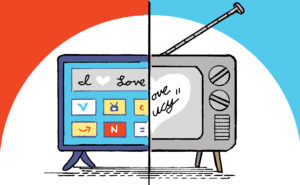If a brand has first-party data and a little inventory of its own, dollars to doughnuts it’ll launch a media network.
We’ve seen grocery chains do it, hotels, big-box retailers, airlines, rideshare companies, gyms, convenience stores, makeup brands – the fruit hangs low.
But over the past year, companies with financial information have also started getting in on the trend, including Chase Media Solutions (as in, Chase Bank), banking app Revolut, payment providers PayPal and Klarna, and, most recently, Western Union.
Last month, the money transfer company – which, fun fact, sent its first telegrams across the American frontier in the early 1850s – launched a media network that claims to touch 150 million people across the US and Europe.
The purpose of Western Union’s media network, according to Chris Hammer, SVP of global digital product and commerce innovation, is to connect its customers “with brands that drive unique and relevant value to an aspiring multicultural population.”
That might sound like an excerpt from a press release, but the sentiment is genuine, Hammer said.
“We’re not trying to spam and blitz our customers just because we have data about them,” he said. “We see this as part of our mission, which is to create opportunities for an underserved, underbanked and mostly migrant population.”
Money moves
Many of Western Union’s customers work in the US and regularly send money home to their families in other countries.
And the destination of a wire transfer can say a lot about the sender, Hammer said.
For example, there are notable linguistic and cultural variations between a customer raised in Mexico versus the Dominican Republic or in Cuba versus Venezuela.
“It’s important to understand the nuances,” Hammer said. “A lot of folks dabble in multicultural advertising and targeting using third-party attributes, but we’re primarily operating with first-party data.”
Beyond country of origin and other information related to the transaction itself, Western Union also knows how frequently customers visit one of their agent locations, of which there are more than 400,000 around the world and 40,000 in the US alone.
Western Union can serve ads in these locations. People typically spend somewhere between 15 and 20 minutes waiting in line to send or receive money or to cash a check.
“That’s a time when we have their attention,” Hammer said.
Beyond its own on-site and in-app inventory, including display, online video and OTT, Western Union also operates a network of digital signage both within its retail locations and across thousands of supermarkets, pharmacies, convenience stores, banks and check cashing facilities.
“We’re not a Walmart or a Target,” Hammer said, “but we are combining physical retail and digital to help brands personalize content and reach customers where they are.”
Fruit of the union
So far, Western Union has had interest in its media network from banks, credit card providers and brands selling entry-level financial products and services. That makes sense.
“This is an outlet for them to reach unbanked, multicultural customers they might otherwise have trouble finding and engaging with,” Hammer said.
But there’s also been outreach from quick-service restaurants, CPG brands and telcos with prepaid calling cards and starter phone plans, as well as from advertisers that want to use Western Union’s DOOH network for public service announcements and to promote local sporting events.
There are certain verticals, though, that Western Union is extra careful with, even though they might seem like a good match for its audience on the surface.
Western Union customers are often in constant communication with family and friends in other countries, but rarely have a lot of disposable income.
“If we’re out there pushing cruise vacations to someone who’s scraping together every penny they don’t send home to use for their own utilities and essentials,” Hammer said, “that looks pretty disingenuous of us.”
By the same token, Western Union customers must opt into the program before their data is used for any form of targeted marketing.
“As a financial services organization, privacy and responsible consent management are at the core of how we make decisions about the network, including how we scale it,” Hammer said.
Checks and balances
Western Union mostly built the programmatic pipes in-house for its owned-and-operated web and app inventory, which is available both as a managed service and through a self-serve option.
But Western Union is working with a bunch of partners for off-site targeting and placements, including DSPs, SSPs, multiple CDPs and other data partners, identity providers and affiliate media companies.
And it has relationships with other publishers to help them strengthen their multicultural audience reach, Hammer said.
Building its media business took a significant investment of time and money over the past year and a half, which is “one reason you’re only seeing this announcement from us now,” he said. “It’s been a lot of work to bring this to life.”
But, and this is the eternal question for any brand launching its own media network: Isn’t there already too much media fragmentation as it is? Give buyers a break.
Yes, it’s getting crowded. But there’s room for anyone with a differentiated product, Hammer argued.
“The way we’re breaking through the noise is with our audience,” he said. “We have a real and direct relationship with a diverse customer base and we’ve found that this really matters to the advertisers and agencies we talk to.”














